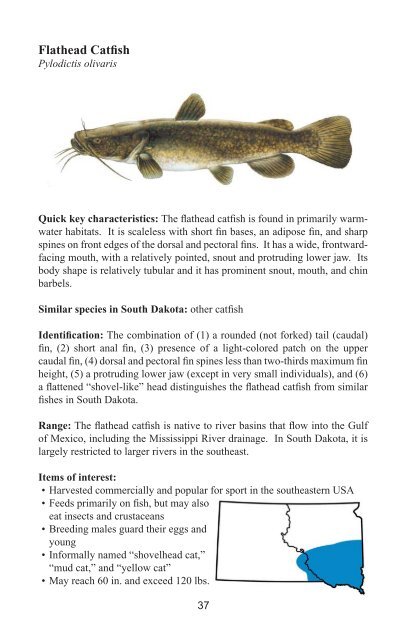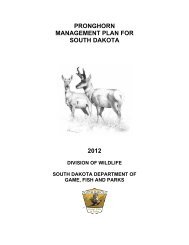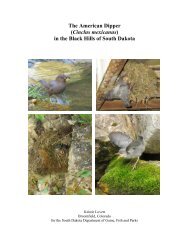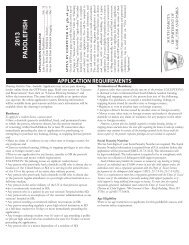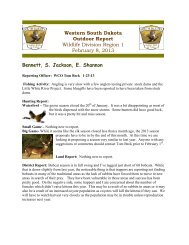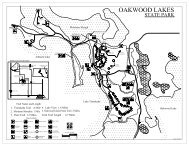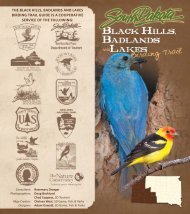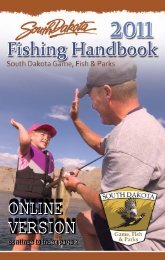pdf version - South Dakota Department of Game, Fish and Parks
pdf version - South Dakota Department of Game, Fish and Parks
pdf version - South Dakota Department of Game, Fish and Parks
You also want an ePaper? Increase the reach of your titles
YUMPU automatically turns print PDFs into web optimized ePapers that Google loves.
Flathead Catfi sh<br />
Pylodictis olivaris<br />
Quick key characteristics: The fl athead catfi sh is found in primarily warmwater<br />
habitats. It is scaleless with short fi n bases, an adipose fi n, <strong>and</strong> sharp<br />
spines on front edges <strong>of</strong> the dorsal <strong>and</strong> pectoral fi ns. It has a wide, frontwardfacing<br />
mouth, with a relatively pointed, snout <strong>and</strong> protruding lower jaw. Its<br />
body shape is relatively tubular <strong>and</strong> it has prominent snout, mouth, <strong>and</strong> chin<br />
barbels.<br />
Similar species in <strong>South</strong> <strong>Dakota</strong>: other catfi sh<br />
Identifi cation: The combination <strong>of</strong> (1) a rounded (not forked) tail (caudal)<br />
fi n, (2) short anal fi n, (3) presence <strong>of</strong> a light-colored patch on the upper<br />
caudal fi n, (4) dorsal <strong>and</strong> pectoral fi n spines less than two-thirds maximum fi n<br />
height, (5) a protruding lower jaw (except in very small individuals), <strong>and</strong> (6)<br />
a fl attened “shovel-like” head distinguishes the fl athead catfi sh from similar<br />
fi shes in <strong>South</strong> <strong>Dakota</strong>.<br />
Range: The fl athead catfi sh is native to river basins that fl ow into the Gulf<br />
<strong>of</strong> Mexico, including the Mississippi River drainage. In <strong>South</strong> <strong>Dakota</strong>, it is<br />
largely restricted to larger rivers in the southeast.<br />
Items <strong>of</strong> interest:<br />
• Harvested commercially <strong>and</strong> popular for sport in the southeastern USA<br />
• Feeds primarily on fi sh, but may also<br />
eat insects <strong>and</strong> crustaceans<br />
• Breeding males guard their eggs <strong>and</strong><br />
young<br />
• Informally named “shovelhead cat,”<br />
“mud cat,” <strong>and</strong> “yellow cat”<br />
• May reach 60 in. <strong>and</strong> exceed 120 lbs.<br />
37


